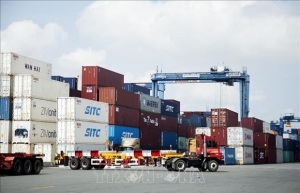Vietnam must be prepared for further global impediments
What is your take on the Vietnamese economic outlook for the second half of 2024 and the year as a whole?
According to the ADB’s latest forecast, the growth outlook for Vietnam in 2024 and 2025 remains unchanged at 6 and 6.2 per cent respectively, on the back of a strong first-half performance in 2024.
 |
| Nguyen Ba Hung, principal country economist from the Asian Development Bank (ADB) in Vietnam |
However, trade-related manufacturing - one of its main drivers of recovery - is expected to slow down over the near term, while domestic demand will also remain subdued. Inflation is projected to stabilise at 4 per cent during the above two-year period.
From now until the end of this year, economic growth is projected to slow down compared to the first half due to lingering difficulties. We do not expect that exports and imports will continue witnessing strong double-digit growth, as we saw in the first half of this year.
In the first six months of 2024, the Vietnamese economy’s total import and export turnover of goods is estimated to have reached $368.53 billion, up 14.5 per cent on-year. However, such high growth was also resulting from the low-base situation, compared to 15.2 per cent contraction in the first half of 2023. The trade landscape in the second half of 2023 witnessed a solid recovery, which will be basis that further growth in 2024 will be at lower pace.
Thus, considering the lingering difficulties, it would be very difficult to boost economic growth in the coming months.
Last year, the economy grew 3.41 per cent in Q1, 4.25 per cent in Q2, 5.47 per cent in Q3, and 6.72 per cent in Q4. This year, the rate reached 5.66 per cent in Q1 and 6.93 per cent in Q2. However, close analysis would show that such high growth largely relied on exports and imports as a key driver.
It is likely that in Q3 and Q4 this year, this key driver will not be maintained due to continued difficulties in the global economy with demand on a downtrend. This would mean that the economic growth for these two quarters will likely be at lower rates.
For example, if the economy grows by 6 per cent in the second half, the entire-year growth rate will be 6.2 per cent. Nevertheless, the world economy is facing significant difficulties which the Vietnamese economy is open to, with total export and import turnover almost doubling GDP.
If the economy only managed weaker growth at around 5.7-5.8 per cent level in the second half, which is still a good performance compared to regional economies. In that case, the growth rate for the whole year would 6 per cent – compared to the government’s expectation of 7 per cent.
What will be the main propellant of economic growth for the rest of 2024?
At present, the key impetus for economic growth consists in domestic consumption demand and investment. The government should continue improving the investment and business climate, and stimulating domestic consumption. Domestic demand boost could target private consumption, public consumption, and public investment. These three factors will generate higher demand to support private investment growth.
To promote these impetuses, the government would need to place a focus on expanding the fiscal policy in which public expenditure can be implemented in a more effective manner.
At present, the state budget expenditure for 2024 has been approved, but how to spend effectively remains to be seen. Last year, the realised state budget expenditure was around 83 per cent of the approved plan. That shows the significant room to improve expenditure performance to boost public consumption and investment.
Accelerating public investment disbursement can create more jobs and incomes, and help attract private investments. This would accordingly help domestic businesses to increase investment and consumption.
Additionally, the government can continue reducing taxes and fees for enterprises and individuals. This will help spur on private consumption as with the same amount of disposable money, one can buy more goods with a tax reduction.
The government can also offer more assistance to labourers, especially those who lose their jobs or work with reduced hours, which will help supplement their reduced income. More support could also be offered to businesses in human resources training, preparing for the strong recovery of the economy, in which companies would need a large quantity of high-quality employees.
It was mentioned that trade-related manufacturing is expected to slow down over the near term. Could you elaborate on this?
In the first half of 2023, demands for goods in the global market declined, including for Vietnamese goods. However, the demands bounced back in the first six months of this year, but compared to a low base in the corresponding period last year, and such a rebound was at a similar level to compensate for the drop in the same period of 2023.
However, the world economy is still facing difficulties, with weak growth of demand for goods, and undoubtedly Vietnam’s economy will be affected. In the second half of this year, it is unlikely that Vietnam will continue to record a double-digit growth rate in export turnover, as it will be compared to a higher base of the second half of 2023.
When global growth remains weak, demands for Vietnamese goods will also slow down.
What will be the most enduring challenges for Vietnam’s economic growth?
The external challenge is the slowing down of the world economy in the near term. Another challenge is that while Vietnam’s growth largely relies on exports, this is mainly carried out by foreign investment enterprises. Softened global demand caused by slow economic recovery among Vietnam’s trading partners and continued geopolitical tensions, both of which would slow down the recovery of the country’s export-led growth.
Meanwhile, the internal challenge is more enduring and significant, and the domestic economic situation remains difficult. For example, despite some improvements, public investment still faces a raft of impediments. Also, cumbersome administrative procedures still exist, making it complex for attracting more private investment.
Further reform to improve the business environment, reduce costs of doing business, and linking domestic firms to global and regional supply chains already present in the country will help boost growth further.
In addition, agricultural production has been suffering from adverse weather conditions, with many regions hit hard by drought earlier this year. It is forecast that more rainfall will happen this year, which could be positive for agricultural production but raising risks of flooding or other hazards that need to be managed and mitigated.
 | Vietnamese economy likely to expand by 6.5 per cent in 2024: Economist The Vietnamese economy is likely to expand by 6-6.5 per cent in the base scenario, with even recovery recorded in all sectors of agriculture, industry, construction and services, Dr. Can Van Luc, a member of the National Financial-Monetary Policy Advisory Council, has predicted. |
 | Vietnamese economy fared well in Q1 despite external risks The global economy is facing several headwinds, including the slowdown in China and the Eurozone as well as the US Fed's possible delay of interest rate cuts. In this context, ASEAN may be a global safe haven for economic growth. Abel Lim, head of Wealth Management Advisory and Strategy at UOB, discussed with VIR's Thanh Van the outlook of the global economic condition and its impact on Vietnam. |
What the stars mean:
★ Poor ★ ★ Promising ★★★ Good ★★★★ Very good ★★★★★ Exceptional
 Tag:
Tag:
Related Contents
Latest News
More News
- Main drivers for Vietnam’s digital economy future (December 03, 2025 | 11:35)
- Pivotal stage of growth paves way for rise in M&As (December 03, 2025 | 10:00)
- Positive projections for M&A interest from Thailand (December 03, 2025 | 09:40)
- Manifesting the first line of defence in cybersecurity (December 03, 2025 | 09:00)
- The transformational role AI can play in accounting arena (December 03, 2025 | 08:00)
- Unlocking 5G-AI potential in Singapore (December 03, 2025 | 08:00)
- Data-driven strategies vital for a fast-evolving nation (December 02, 2025 | 09:41)
- Policy to practice: how Vietnam can lead the region (November 26, 2025 | 16:03)
- Mobilising private capital at scale vital for climate battle (November 26, 2025 | 15:36)
- VILAF and Yoon & Yang launch Vietnam - Korea Practice Unit (November 26, 2025 | 15:16)






















 Mobile Version
Mobile Version